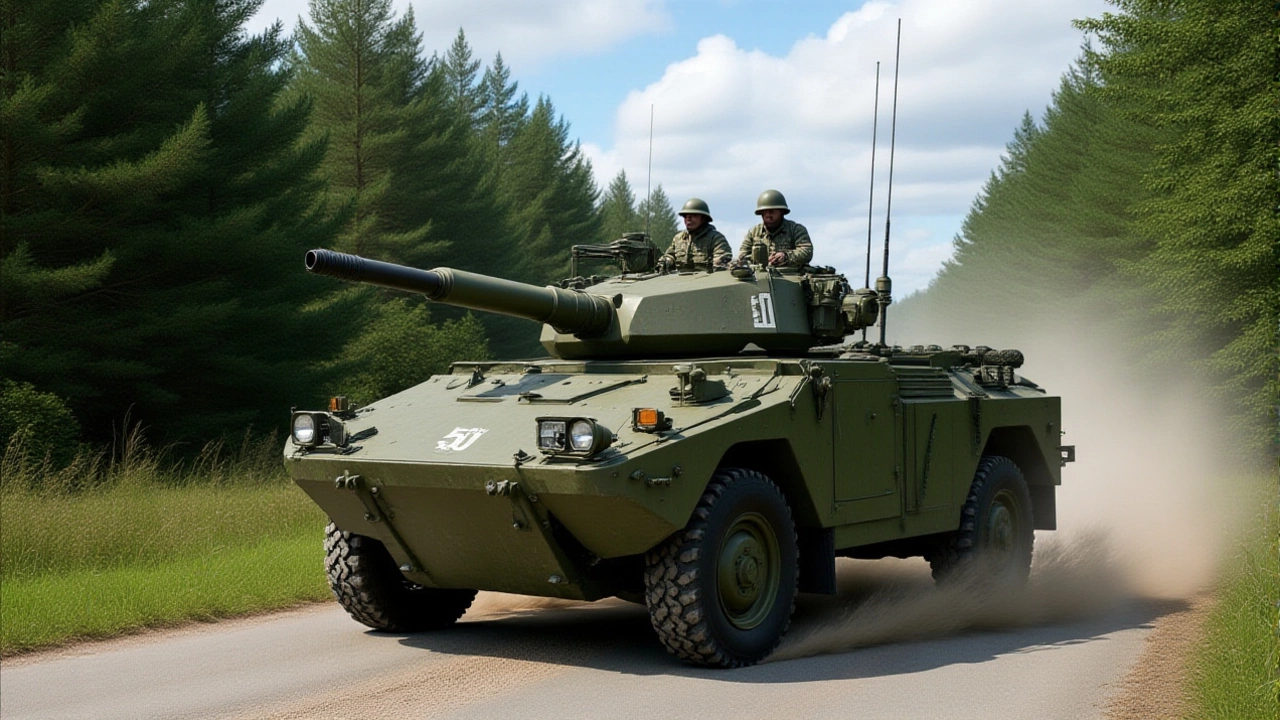On September 9, 2025, the British Army took a decisive step into its future when General Dynamics Land Systems–UK and Lockheed Martin UK unveiled the AJAX Infantry Fighting Vehicle (IFV)London at the Defence and Security Equipment International (DSEI)London exhibition. This wasn’t just another vehicle reveal. It was the moment Britain finally answered the question hanging over its armored forces for over a decade: What comes after the Warrior?
The Warrior Problem and the Urgent Need for Change
The British Army’s Warrior infantry fighting vehicle has been in service since the 1980s. Aging, undergunned, and increasingly vulnerable to modern threats, it’s been a symbol of capability erosion — not progress. For years, the Ministry of Defence (UK MoD) tried to upgrade it through the Warrior Capability Sustainment Programme (WCSP), but the program stalled, ballooned in cost, and lost momentum. By 2023, the Army had fewer than 100 operational Warriors ready for deployment. The Strategic Defence Review (SDR) 2025 didn’t mince words: Britain needed to rebuild its armored infantry battalions. At least four of them. And fast.
Enter the AJAX IFV. It’s not a clean-sheet design. It’s a smart evolution — built on the 147 AJAX vehicles already delivered to the Army, sharing the same chassis, powerpack, and digital backbone. That’s not an accident. It’s logistics genius. Training, spare parts, maintenance — all of it aligns with what’s already in service. No need to train two separate fleets. No need to stockpile two sets of tools. This is how you modernize without breaking the bank.
The Turret That Changed Everything
Here’s the twist: the real innovation isn’t in the hull. It’s in the turret. Developed at Lockheed Martin’s Ampthill facility in Bedfordshire, the new uncrewed turret is a marvel of modern warfare tech. It carries the 40 mm CTA cannon — the same one originally bought for the Warrior upgrade program. And guess what? The UK MoD still has 245 of them sitting in warehouses. Now they’re being put to use. Brilliant.
It’s not just about the gun. The turret integrates the Thales gunner sight and commander’s panoramic periscope — enabling hunter-killer targeting. It’s protected by Elbit Systems’ Iron Fist active protection system, which can intercept incoming RPGs and anti-tank missiles from any direction. And here’s the kicker: it’s optionally manned. That means if the battlefield gets too hot, soldiers can climb into a small basket inside the turret. Not standard. Not common. But possible. That’s flexibility.
On the right side, a single Javelin missile launcher is mounted — but it’s modular. Swap it out for a loitering munition, or even a drone-deployed sensor. The turret’s designed to evolve. As Scott Milne, Vice President & General Manager at General Dynamics Land Systems–UK, put it: “It’s not just a platform — it’s a product of the UK’s Defence Industrial Strategy.”

Production, Export, and the Race Against Time
Right now, Lockheed Martin UK is churning out 5 to 6 turrets per month at Ampthill — single shift. That’s not enough. The Army needs 150+ IFVs to equip those four battalions. And that’s before export orders start rolling in. Poland, Sweden, and Australia are already circling. A double shift? That’s on the table. Production could ramp up to 12 turrets monthly by mid-2026.
But the real pressure isn’t just on manufacturing. It’s on timing. On the very day the AJAX IFV was unveiled, the British Army confirmed that its existing AJAX reconnaissance variant — the ARES — had achieved Initial Operating Capability. That’s huge. But there are only 93 ARES vehicles. Barely enough for one brigade. The IFV isn’t a luxury. It’s a lifeline.
Why This Matters Beyond the British Army
This isn’t just about replacing old metal with new. It’s about redefining what a modern infantry fighting vehicle can be. The AJAX IFV is built for multi-domain operations — seamless communication with drones, satellites, and allied units across NATO. Its digital architecture is open, adaptable, and export-ready. That’s a game-changer for the UK’s defense industry. For decades, Britain exported tanks and armored vehicles. Then the exports dried up. Now, with this vehicle, the UK has something that’s not just good — it’s competitive on the global stage.
Paul Livingston CBE, Chief Executive of Lockheed Martin UK & NATO, summed it up: “Survivability, lethality, adaptability, and exportability — these aren’t abstract ideals. They’re built into the design.” And he’s right. This vehicle doesn’t just fight. It talks. It learns. It upgrades. It connects.

What’s Next? Prototypes, Hatches, and Air Defense
Don’t think this is the final version. Prototypes for new features are due in early 2026. One of the most intriguing? Under-armour hatches inside the turret — allowing soldiers to load ammunition without exposing themselves. Another? Integrating short-range air defense systems. Imagine an AJAX IFV that can shoot down drones and helicopters. That’s not science fiction. It’s the next software update.
And then there’s the big question: Will this vehicle finally deliver on the promise of the Warrior replacement? The Army says yes. But the proof will be in the mud, the sand, and the snow of future deployments. The AJAX IFV isn’t perfect. It’s still being tested. But for the first time in 20 years, Britain has a credible, modern, and scalable solution.
Frequently Asked Questions
How many AJAX IFVs will the British Army need, and when will they be delivered?
The British Army requires at least 150 AJAX IFVs to fully equip four armored infantry battalions under the SDR 2025 plan. Production of the turret is currently at 5–6 per month at Ampthill, with a target to reach 12 per month by late 2026. Full-scale delivery is expected to begin in Q2 2027, with all vehicles fielded by 2030.
Why does the AJAX IFV use the 40 mm CTA cannon instead of a 30 mm or 25 mm gun?
The 40 mm Cased Telescoped Armament (CTA) was chosen because the UK MoD still has 245 of these guns in storage from the failed Warrior upgrade program. Using them saves £120 million in procurement costs and ensures logistical commonality. The 40 mm round offers superior armor penetration and explosive effect over 30 mm, making it ideal for urban and open terrain combat.
Is the AJAX IFV truly unmanned, or can soldiers operate it from inside?
Lockheed Martin defines it as ‘optionally manned.’ While the default configuration is uncrewed — with the crew safely inside the hull — a small basket and crew stations can be added for direct turret operation. This gives commanders flexibility in high-risk environments where manual control is preferred, such as close-quarters urban warfare or when electronic systems are jammed.
How does the AJAX IFV improve interoperability with NATO allies?
The AJAX IFV uses a standardized digital architecture compatible with NATO’s MCLOS (Modular Common Linking Open System) and the U.S. Army’s Integrated Tactical Network. It can share targeting data, drone feeds, and situational awareness with American M2 Bradley variants, German Puma IFVs, and French SCORPION vehicles — enabling seamless joint operations without costly upgrades.
What’s the export potential for the AJAX IFV and its turret?
Multiple countries, including Poland, Sweden, Australia, and Finland, have expressed interest in acquiring either the full IFV or just the Lockheed Martin turret for integration onto their own platforms. Export sales could begin as early as 2027, with the turret alone potentially generating £300–500 million in revenue over five years, supporting UK jobs and defense sovereignty.
What happened to the original Warrior upgrade program?
The Warrior Capability Sustainment Programme (WCSP) was cancelled in 2021 after costing £1.2 billion and delivering only 12 upgraded vehicles. It suffered from technical overreach, poor management, and shifting requirements. The AJAX IFV is the pragmatic response: reuse proven components, avoid reinventing the wheel, and deliver capability faster — even if it means accepting incremental upgrades rather than a full overhaul.
